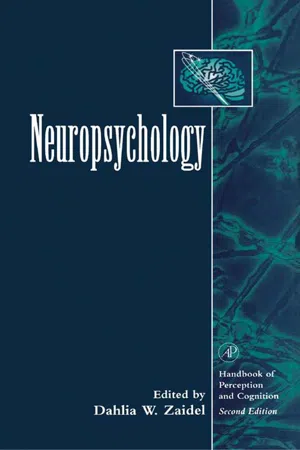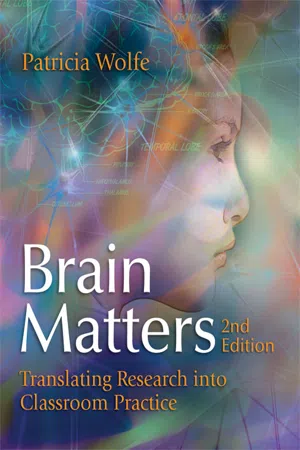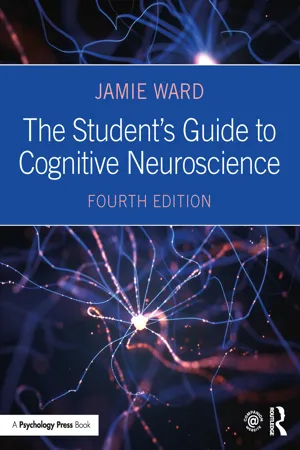Psychology
Brain Structure
The brain structure refers to the physical arrangement of the brain's components, including the cerebral cortex, cerebellum, and brainstem. These components are responsible for various functions such as cognition, emotion, and motor control. Understanding brain structure is crucial in studying how different areas of the brain contribute to behavior, thoughts, and emotions.
Written by Perlego with AI-assistance
Related key terms
11 Key excerpts on "Brain Structure"
- eBook - ePub
- Milton J. Dehn, Alan S. Kaufman, Nadeen L. Kaufman(Authors)
- 2022(Publication Date)
- Wiley(Publisher)
Three THE NEUROPSYCHOLOGY OF PSYCHOLOGICAL PROCESSESThe main purpose of this chapter is to provide an overview of the Brain Structures and functions involved in each of the 14 psychological processes. Knowing some basics about the neuroanatomy of psychological processes can enhance our understanding of how brain‐based processes influence learning and how dysfunctions or deficits in specific neuropsychological processes can impair specific types of learning and performance. Neuroanatomy also illustrates how and why some psychological processes are interrelated. For example, impairment in a visual pathway that connects the occipital and temporal lobes may account for a deficit in rapid automatic naming, a task that, on the surface, appears to depend primarily on memory processes.The human brain is incredibly complex, and much of its functioning is not fully understood. Some of the 14 processes can be more readily mapped to specific brain regions and structures than others. However, most brain‐processing relationships involve interrelated brain networks; very few specific processes function in just one Brain Structure. This chapter will not review all brain anatomy or all types of processing but focuses mainly on the 14 processes and the primary Brain Structures involved in these specific processes. Detailed neuroanatomy of several of the 14 processes can be found in Miller and Maricle (2019 ). For more details on brain anatomy, see Carter et al. (2019 ), Hale and Fiorello (2004 ), and Reynolds and Fletcher‐Janzen (1997 ).OVERVIEW OF Brain StructureS AND FUNCTIONS
Brain Cells
The brain's nerve cells, known as neurons, make up less than 10% of the brain's volume. The remaining cells, known as glial cells, are support cells that provide such functions as supplying the neurons with glucose. What allows the brain to function as an integrated whole is the ability of each neuron to send and receive signals with countless neurons. Signals are sent out from a neuron on a long, thin extension known as an axon. Receiving the signals are numerous, shorter extensions known as dendrites. The axons and dendrites exchange signals across a small gap known as a synapse. Most growth in brain size after birth results from myelination - eBook - ePub
- Dahlia W. Zaidel(Author)
- 2013(Publication Date)
- Academic Press(Publisher)
CHAPTER 2Neuroanatomy
Brain Structure and Function
Jeffrey M. ClarkePublisher Summary
This chapter presents an introduction to different issues concerning the relationship between brain anatomy and brain function. It discusses how an understanding of anatomical–behavioral relationships begins at the microscopic level. Anatomical studies have shown that functionally distinct brain regions often exhibit striking differences in the physical characteristics of the neurons present and the pattern of connections between them. The chapter also discusses the issue of localizing functionally distinct regions of the brain. It describes the subdivisions or lobes of the brain and provides an overview of the primary functions ascribed to each region. The chapter focuses on the neocortex that comprises about 80% of the human brain and consists of the two cerebral hemispheres, the left and the right. It also describes the technological tools that provide researchers with powerful means for studying the anatomy and the physiology of the living human brain. The chapter further discusses the structure–function relationships associated with brain size and two Brain Structures, that is, the planum temporale and the corpus callosum.I INTRODUCTION
This chapter will serve as an introduction to a number of issues concerning the relationship between brain anatomy and brain function. First, I will show how an understanding of anatomical–behavioral relationships begins at the microscopic level. One may wonder how we can ever comprehend the underlying functioning of the human brain given that some 50 billion brain cells, known as neurons, are involved in information processing, and that each of these neurons can receive up to 15,000 connections from other neurons (Kolb & Whishaw, 1990 - eBook - ePub
Brain Matters
Translating Research into Classroom Practice
- Patricia Wolfe(Author)
- 2010(Publication Date)
- ASCD(Publisher)
Part 1 The Structure and Function of the Human Brain The more we understand the brain, the better we'll be able to design instruction to match how it learns best. The human brain is not the largest organ in the body. It weighs only about three pounds, less than the skin covering your body. Yet this marvelous structure is the source of all human behavior, simultaneously controlling a myriad of unbelievably complex functions. Within a span of time too short for humans to measure, it receives information and relays it to the appropriate locations for processing. It then allows you to act on these data by controlling the motor output of your muscles. Your brain generates emotions and lets you be aware of them. It is the source of cognition, memory, thoughts, and what we call intelligence. Your ability to speak and understand the speech of others comes from the brain. You don't have to worry about controlling your heart rate, respiration, breathing, hormone secretion, or immune system; the brain does this for you unconsciously and automatically. In Part I of this book, we'll take a look at the major structures of the brain and the roles they play. You may be wondering why you need all this biology. Wouldn't it be sufficient just to outline the general findings about how the brain learns without understanding the structures involved? Isn't it possible to have a general understanding of research findings and perhaps even apply the findings without really comprehending what is going on in the brain? Perhaps, but I believe that if we are to become critical consumers of neuroscience and cognitive science research, or even read reports of this research in the media with any understanding, we need to have a working knowledge of the human brain. Leslie Hart, in his book Human Brain, Human Learning (1983), talks about how little sense it would make to design a device to be used by human hands without being sure that you considered the nature of hands - Nick Haslam, Luke Smillie(Authors)
- 2022(Publication Date)
- SAGE Publications Ltd(Publisher)
This includes both grey matter (dense concentrations of cell bodies) and white matter (tracts of nerve fibre connecting different brain regions). A helpful analogy is to think of the brain as a computer laboratory, in which the various computer systems represent the grey matter while the cables connecting the systems represent the white matter. Brain function refers to the role served by activity in specific regions of the brain. In our computer lab analogy, one of our machines might function primarily as a server while another might be primarily used for backup data. Functions might also be distributed across multiple structures comprising a network. Theory building in biological psychology might begin by postulating a CoNS in functional terms (e.g., a ‘pleasure system’) and then attempt to find the structures in the brain that perform these functions. Alternatively, it might begin by studying a particular Brain Structure, and attempting to identify the functions it performs. Studying Brain Structure and function requires specialized (and often expensive) equipment, and personality neuroscience has developed relatively slowly due to its reliance on technological advances. Long ago, the only way to understand the functions of certain Brain Structures was to study people who had sustained some kind of brain injury and observe how they had changed psychologically. A classic illustration is provided by Phineas Gage, the 19th-century construction worker who suffered damage to frontal areas of his brain in a blasting accident that he miraculously survived. Gage’s pronounced changes in personality – which largely consisted of increased impulsivity and short-sighted behaviour – were noted in detail by his physician, while his friends remarked that he was ‘no longer Gage’. Researchers who study the region of the brain that was damaged in Gage’s accident, part of the prefrontal cortex (see Figure 6.1), continue to see his case as informative (Damasio, 1994)- eBook - ePub
Psychological Criminology
An Integrative Approach
- Richard Wortley(Author)
- 2023(Publication Date)
- Routledge(Publisher)
Examined in this chapter is the pivotal role in criminal behaviour played by the brain as it mediates between internal biological inputs and external environmental inputs. The area of psychology concerned with Brain Structure and function is neuropsychology. Neuropsychologists examine the biological events in the brain that underlie human action, emotion and thought, including those associated with criminal behaviour. They are concerned with both normal Brain Structures and functions, and with the behavioural implications of brain impairments. We begin with an overview of the general field of neuropsychology, before moving to a more specific discussion of neuropsychological correlates and explanations of criminal behaviour.Basic Brain Structures and functions
Neuropsychology, like behavioural genetics, is a specialist field and it is beyond the scope of this book to cover it in detail here. What follows, then, is a simplified description of basic Brain Structures and functions that are especially relevant to neuropsychological explanations of crime; namely, the nervous system, biochemical messengers, brain anatomy, and environmental impacts on brain development.The nervous system
The brain is part of the body’s nervous system, a network of nerve cells – or neurons – that is responsible for all psychological, behavioural, and physiological activity. The basic job of a neuron is to relay information. Neurons come in a variety of shapes and have different specialised functions, but most comprise four main structures. The body of the neuron is called the soma and houses the basic machinery of the cell. Extending from the soma are tree-like fibres – hundreds or even thousands in number – called dendrites, which have receptors responsible for receiving messages from other neurons. Also extending from the soma is a slender tube called an axon, which is responsible for sending messages. The axon divides and branches, and at the ends of the branches are terminal buttons from which the messages are sent. A simplified diagram of a neuron is shown in Figure 4.1.Figure 4.1A neuron.The nervous system is divided into two parts – the central nervous system (CNS) and the peripheral nervous system (PNS) (see Figure 4.2 - eBook - ePub
Psychological Criminology
An Integrative Approach
- Richard Wortley(Author)
- 2011(Publication Date)
- Willan(Publisher)
Examined in this chapter is the pivotal role in criminal behaviour played by the brain as it mediates between internal biological inputs and external environmental inputs. The area of psychology concerned with Brain Structure and function is neuropsychology. Neuropsychologists examine the biological events in the brain that underlie human action, emotion and thought, including those associated with criminal behaviour. They are concerned with both normal Brain Structures and functions, and with the behavioural implications of brain impairments. We begin with an overview of the general field of neuropsychology, before moving to a more specific discussion of neuropsychological correlates and explanations of criminal behaviour.Basic Brain Structures and FunctionsNeuropsychology, like behavioural genetics, is a specialist field and it is beyond the scope of this book to cover it in detail here. What follows, then, is a simplified description of basic Brain Structures and functions that are especially relevant to neuropsychological explanations of crime.The Nervous SystemThe brain is part of the body’s nervous system, a network of nerve cells – or neurons – that is responsible for all psychological, behavioural and physiological activity. The basic job of a neuron is to relay information. Neurons come in a variety of shapes and have different specialised functions, but most comprise four main structures. The body of the neuron is called the soma and houses the basic machinery of the cell. Extending from the soma are tree-like fibres – hundreds or even thousands in number – called dendrites, which have receptors responsible for receiving messages from other neurons. Also extending from the soma is a slender tube called an axon, which is responsible for sending messages. The axon divides and branches, and at the ends of the branches are terminal buttons from which the messages are sent. A simplified diagram of a neuron is shown in Figure 4.1.Figure 4.1A neuron.The nervous system is divided into two parts: the central nervous system (CNS) and the peripheral nervous system (PNS) (see Figure 4.2). The CNS comprises the brain and the spinal cord and is the body’s ‘command centre’. The brain receives and processes stimuli from inside and outside of the body, it interprets and stores information, and it dispatches messages to initiate responses. The spinal cord is connected to the base of the brain and primarily acts as a conduit between the brain and the rest of the body below the neck. - eBook - ePub
Criminals in the Making
Criminality Across the Life Course
- John Paul Wright, Stephen G. Tibbetts, Leah E. Daigle(Authors)
- 2014(Publication Date)
- SAGE Publications, Inc(Publisher)
The brain, composed of many regions and structures, is the most important organ in the commission and inhibition of criminal behavior. This much we know. However, outside of this general statement, links between specific Brain Structures and particular types of behavior have not been well established. This is largely due to the fact that our understanding of the brain and its development is still rather primitive. The good news is that scientific knowledge on cognition is growing at an exponential rate. Because of this immense growth in information, a comprehensive description of brain development would take many volumes. Therefore, our review in this chapter (and the following chapter) focuses on the essentials most relevant in understanding neurological influences in individuals’ development toward criminality.It should be noted that developmental differences may be related to brain structure and/or brain function, which may occur independently or simultaneously. In other words, a topographical image of an individual's Brain Structure may appear quite normal, whereas the actual functioning (internally, externally, or both) may be abnormal due to structural maladies that do not allow healthy functioning of the brain. Given this distinction, we first examine brain configuration and issues related to formative development. After identifying individual Brain Structures and their location, we provide descriptions of the primary jobs each structure carries out. Most importantly, we discuss some of the observed links between these specific Brain Structures and criminality. Thus, the focus in this chapter is on hindbrain and subcortical structure and region-specific regulations, whereas the foreBrain Structure is the focus of the following chapter, and the specific mechanics of brain and nervous system functioning is the emphasis of the following chapters.The reader should keep in mind that some of the current conclusions regarding links with criminal behavior are still somewhat preliminary and not yet well established. Future research will ultimately determine which of these associations is valid in explaining decisions to commit (or not commit) crime. Nevertheless, we provide the current state of understanding regarding brain development and criminality. - eBook - ePub
- Jamie Ward(Author)
- 2019(Publication Date)
- Routledge(Publisher)
Chapter 2 Introducing the brainDOI: 10.4324/9781351035187-2CONTENTS
- Structure and function of the neuron
- The gross organization of the brain
- The cerebral cortex
- The subcortex
- The midbrain and hindbrain
- Summary and key points of the chapter
- Example essay questions
- Recommended further reading
It is hard to begin a chapter about the brain without waxing lyrical. The brain is the physical organ that makes all our mental life possible. It enables us to read these words, and to consider thoughts that we have never considered before—or even to create thoughts that no human has considered before. This book will scratch the surface of how this is all possible, but the purpose of this chapter is more mundane. It offers a basic guide to the structure of the brain, starting from a description of neurons and working up to a description of how these are organized into different neuroanatomical systems. The emphasis is on the human brain rather than the brain of other species.Structure and Function of the Neuron
All neurons have basically the same structure. They consist of three components: a cell body (or soma), dendrites and an axon, as shown in Figure 2.1 . Although neurons have the same basic structure and function, it is important to note that there are some significant differences between different types of neurons in terms of the spatial arrangements of the dendrites and axon.Figure 2.1 Neurons consist of three basic features: a cell body, dendrites that receive information and axons that send information. In this diagram the axon is myelinated to speed the conduction time.The cell body contains the nucleus and other organelles. The nucleus contains the genetic code, and this is involved in protein synthesis. Proteins serve a wide variety of functions from providing scaffolding to chemical signaling (they can act as neurotransmitters and receptors in neurons). Neurons receive information from other neurons and they make a “decision” about this information (by changing their own activity) that can then be passed on to other neurons. From the cell body, a number of branching structures called dendrites enable communication with other neurons. Dendrites receive information from other neurons in close proximity. The number and structure of the dendritic branches can vary significantly depending on the type of neuron (i.e., where it is to be found in the brain). The axon, by contrast, sends information to other neurons. Each neuron consists of many dendrites but only a single axon (although the axon may be divided into several branches called collaterals). - No longer available |Learn more
- Nick Haslam, Luke Smillie, John Song(Authors)
- 2017(Publication Date)
- SAGE Publications Ltd(Publisher)
In our computer lab analogy, one of our machines might function primarily as a server while another might be primarily used for backup data. Theory building in biological psychology might begin by postulating a CoNS in functional terms (e.g., a ‘pleasure system’) and then attempt to find the structures in the brain that perform these functions. Alternatively, it might begin by studying a particular Brain Structure, and attempting to identify the functions it performs. Studying Brain Structure and function requires advanced and expensive equipment, and personality neuroscience has developed relatively slowly due to its reliance on technological advances. Long ago, the only way to understand the functions of certain Brain Structures was to study people who had sustained some kind of brain injury and observe how they had changed psychologically. A classic illustration is provided by Phineas Gage, the 19th-century construction worker who suffered damage to frontal areas of his brain in a blasting accident that he miraculously survived. Gage’s pronounced changes in personality – which largely consisted of increased impulsivity and short-sighted behaviour – were noted in detail by his physician, while his friends remarked that he was ‘no longer Gage’. Researchers who study the region of the brain that was damaged in Gage’s accident, called the ventromedial prefrontal cortex, continue to see his case as informative (Damasio, 1994). In recent years, modern brain-imaging (or neuroimaging) methods have made it much easier to study the neural systems underlying personality. Perhaps the most popular methods at present are magnetic resonance imaging (MRI), which quantifies the size or volume of certain Brain Structures, and functional magnetic resonance imaging (fMRI), which quantifies brain activity in terms of blood flow to different regions of the brain - eBook - ePub
- G Neil Martin(Author)
- 2015(Publication Date)
- Routledge(Publisher)
4 The Brain: its Structures, Regions and FunctionsWhat You Will Find in This Chapter
- ■ a description of the major structures and regions of the central nervous system and their role in behaviour
What You Should Be Able to Do after Reading the Chapter
- ■ identify regions of the central nervous system that control or mediate specific behaviours
4.1 Development of the CNS
A human embryo begins life as a hollow tube called a neural tube. As the embryo develops, the tube elongates and folds, and its tissue thickens. The wall's tube is made up of cells that will later become the glial cells and the neurons of the nervous system. At this stage, these cells are called neuroepithelial cells: the prospective glial cells are called spongioblasts and the prospective neurons are called neuroblasts. The inside of the tube forms a canal, which contains cerebrospinal fluid (CSF), a clear, watery liquid that serves a number of functions in the CNS. The head of the embryo develops into the brain; the remainder straightens and becomes the spinal cord.The canal develops four protuberances, which later develop into the brain's four ventricles – chambers deep inside the brain – which contain CSF. The spinal cord end of the canal becomes one long fluid-filled canal that connects the four ventricles of the brain. The ventricles help divide the brain into various general regions called the forebrain, midbrain and hindbrain. The rostral ventricles are called the lateral and third ventricles. The region surrounding the third ventricle is called the endbrain or telencephalon and represents the most recently developed and most sophisticated part of the CNS, the cerebral cortex. The area surrounding the third ventricle becomes the diencephalon, or interbrain.4.2 The Cerebral Hemispheres
The most prominent and distinctive parts of the brain are the cerebral hemispheres. These make up the two 'halves' of the brain and comprise grey matter and white matter, two types of collection of nerve cells. Grey matter is so called because it contains nerve cells' blood capillaries. White matter is made up of processes called axons, which are covered with a milk-coloured membrane. The cerebral hemispheres are responsible for all the major, important sophisticated behaviour we – and other primates – engage in: sensation, perception, remembering, feeling emotion, planning, and so on. Much of the data in this and the next chapters derive from our study of healthy or damaged cerebral hemispheres. - eBook - ePub
A Child's Brain
The Impact of Advanced Research on Cognitive and Social Behavior
- Mary Frank(Author)
- 2021(Publication Date)
- Routledge(Publisher)
ABSTRACT. The human brain is composed of billions of neurons. In this chapter we will examine the properties of the neuron, how neurons interact and how they are organized into subdivisions within the brain. Such information is essential as a framework that can be applied to further considerations of the brain processes involved in the more complicated behaviors of concern to educators.INTRODUCTION
In this chapter and the one that follows, we shall be dealing with the biology and function of the brain. We realize that the readership of this journal will not have an extensive background in the neurosciences and we will attempt to refrain from using the specialized jargon of the neurosciences. In this chapter, we shall consider the basic biology of the brain, what we know of how it operates, and something of how it develops. In the next chapter, we shall consider some aspects of the ultimate expression of brain activity, that is, of course, behavior. In particular, we shall concentrate on those behaviors, and the brain processes that are most relevant to the concerns and needs of the classroom educator.The human brain, like other brains, is composed of individual neurons. Neurobiologists have provided us with a wealth of information concerning the anatomy, physiology, and chemistry of the neuron. They are well on their way to understanding how a single neuron works, and how a few interconnected neurons operate. For those interested in more practical matters, such as educators, this wealth of information is often of little direct relevance. It is assumed, however, that the basic studies that neurobiologists are currently undertaking will eventually shed light on the brain processes underlying higher mental operations. Currently however, the brain processes underlying higher mental operations are largely unknown. As a consequence the two disciplines of Education and Neuroscience are rather far apart. It is our goal to begin to bridge this chasm by encouraging a dialog between educators and neuro-scientists. We feel that educators have much to gain by learning more about the organ they devote their careers toward shaping.
Index pages curate the most relevant extracts from our library of academic textbooks. They’ve been created using an in-house natural language model (NLM), each adding context and meaning to key research topics.










